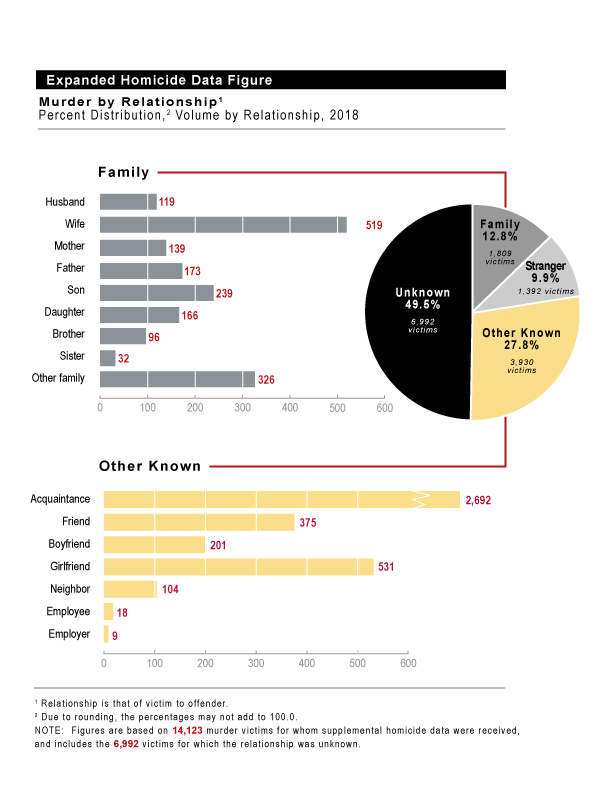Expanded Homicide
Data collection
The FBI’s Uniform Crime Reporting (UCR) Program collects supplementary homicide data that provide the age, sex, race, and ethnicity of the murder victim and offender; the type of weapon used; the relationship of the victim to the offender; and the circumstance surrounding the incident. Statistics gleaned from these supplemental data are provided in this section.
This section also includes information about justifiable homicide—certain willful killings that must be reported as justifiable or excusable. In the UCR Program, justifiable homicide is defined as and limited to:
- The killing of a felon by a peace officer in the line of duty.
- The killing of a felon, during the commission of a felony, by a private citizen.
Because these killings are determined through law enforcement investigation to be justifiable, they are tabulated separately from murder and nonnegligent manslaughter. Justifiable homicide information can be found in Expanded Homicide Data Table 14, “Justifiable Homicide, by Weapon, Law Enforcement, 2014–2018” and Expanded Homicide Data Table 15, “Justifiable Homicide, by Weapon, Private Citizen, 2014–2018.”
Overview
- In 2018, most (77.3 percent) of the 14,123 murder victims for whom supplemental data were received were male. (Based on Expanded Homicide Data Table 1.)
- Of the murder victims for whom race was known, 53.3 percent were Black or African American, 43.8 percent were White, and 2.8 percent were of other races. Race was unknown for 233 victims. (Based on Expanded Homicide Data Table 2.)
- More than 49 percent (49.2) of all murders for which the UCR Program received supplemental data were single victim/single offender situations. (See Expanded Homicide Data Table 4.)
- Of the offenders for whom gender was known, 87.7 percent were male. (Based on Expanded Homicide Data Table 3.)
- When the race of the offender was known, 54.9 percent were Black or African American, 42.4 percent were White, and 2.7 percent were of other races. The race was unknown for 4,821 offenders. (Based on Expanded Homicide Data Table 3.)
- More than 72 percent (72.7) of the homicides for which the FBI received weapons data in 2018 involved the use of firearms. Handguns comprised 64.3 percent of the firearms used in murder and nonnegligent manslaughter incidents in 2018.(Based on Expanded Homicide Data Table 8.)
- In 2018, 27.8 percent of homicide victims were killed by someone they knew other than family members (acquaintance, neighbor, friend, boyfriend, etc.), 12.8 percent were slain by family members, and 9.9 percent were killed by strangers. The relationship between murder victims and offenders was unknown in 49.5 percent of murder and nonnegligent manslaughter incidents. (Based on Expanded Homicide Data Table 10.)
- Circumstances were known for 61.0 percent of murders for which supplementary details were reported in 2018. Of those, 39.4 percent of victims were murdered during arguments. Felony-type murders (i.e., murders that occurred in conjunction with the commission of another felony crime such as rape, robbery, burglary, etc.) accounted for 24.5 percent of homicides for which circumstances were known. (Based on Expanded Homicide Data Table 11.)
- Law enforcement reported 763 justifiable homicides in 2018. Of those, law enforcement officers justifiably killed 410 felons, and private citizens justifiably killed 353 people during the commission of crimes. (See Expanded Homicide Data Tables 14 and 15.)
Expanded Homicide Data Figure
Murder by relationship figure:
In this figure, bar graphs and a pie chart visually represent the relationships of murder victims to their offenders. The statistics are based on the supplementary homicide data that law enforcement agencies submitted to the FBI for 14,123 murder victims who were slain in 2018.
Pie chart:
Of the homicides that occurred in 2018 for which supplementary homicide data were received, the relationships of the murder victims to their offenders were as follows: 1,809 victims (12.8 percent) were slain by family members; 1,392 victims (9.9 percent) were murdered by strangers; and 3,930 victims (27.8 percent) were slain by “other known” offenders. The offenders were not known for 6,992 murder victims (49.5 percent).
Bar graphs:
The first bar graph provides a breakdown of the 1,809 familial relationships of victims to offenders based on supplementary homicide data from 2018: 119 husbands were killed by their wives, 519 wives were slain by their husbands, 139 mothers were murdered by their children, 173 fathers were killed by their children, 239 sons were slain by their parents, 166 daughters were murdered by their parents, 96 brothers were killed by their siblings, 32 sisters were slain by their siblings, and 326 victims were murdered by other family members (i.e., familial relationships other than those mentioned above).
A second bar graph depicts the 3,930 “other known” (that is, nonfamilial) relationships of victims to offenders based on supplementary homicide data from 2018: 2,692 victims were killed by acquaintances, 375 were slain by friends, 201 boyfriends were murdered by their girlfriends, 531 girlfriends were killed by their boyfriends, 104 victims were slain by their neighbors, 18 employees were murdered by their employers, and 9 employers were killed by their employees.

The following tables were compiled using information from the Supplementary Homicide Data:
Expanded Homicide Data Table 1
Expanded Homicide Data Table 2
Expanded Homicide Data Table 3
Expanded Homicide Data Table 4
Expanded Homicide Data Table 5
Expanded Homicide Data Table 6
Expanded Homicide Data Table 7
Expanded Homicide Data Table 8
Expanded Homicide Data Table 9
Expanded Homicide Data Table 10
Expanded Homicide Data Table 11
Expanded Homicide Data Table 12
Expanded Homicide Data Table 13
Expanded Homicide Data Table 14
Expanded Homicide Data Table 15

